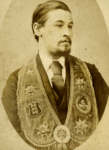The International Order of Good Templars (IOGT) was formed in the USA in 1851 as the ‘Independent Order of Good Templars’ to promote abstinence from alcohol and prohibition of its sales.
It modelled itself on freemasonry’s organisational structures and rituals, but differed in that it encouraged women and children to participate.
Its use of the term ‘Templar’ may have came from a belief that the Knights Templar adhered to temperance (including drinking sour milk rather than alcohol), and from the concept of undertaking a ‘crusade‘, in this case a campaign against alcohol.
The order came to the UK when Joseph Malins (1844-1926) established a lodge in Birmingham in 1868. He had emigrated to Philadelphia, USA, in 1866, where he became involved with the Good Templars, but soon moved back to the UK with his wife due to her ill health.

In Scotland, the organisation started in Glasgow in 1869 and spread quickly.
The first lodge in Langholm was the ‘Rose of Esk Vale’ in February 1871, with Angus Litster (1829-1891), woollen weaver, being a leading figure.
In July 1871, a group from Langholm’s EU Congregational Church formed a lodge called ‘Outward Bound’ shortly before they emigrated to Melbourne in the British colony of Victoria (part of the Commonwealth of Australia from 1901). They then founded the first Good Templar lodge in Victoria in 1872 and its members were influential in the movement’s establishment in the colony.
The main emigre lodge members were:
- Conchie: David, weaver, and Janet (‘Jenny’). They changed their name to McConchie in Victoria were the founders of the extensive McConchie family in Australia and New Zealand, including the members of the McConchie Family Cricket Club.
- Hiddlestone: Robert and Ann (nee Conchie, David’s sister).
- Graham: John and Grace (nee Conchie, David’s daughter).


Others in the emigre group were Jane McVittie, Mary Hounam, William Scott, T Dalgliesh, Ellen Bell and W Forbes.
Langholm’s Rose of Eskdale Lodge declined in the early 1890s. A new lodge, the ‘Star of Eskdale’, was launched in 1894, with Thomas Bell being an initial leader, but it too seems to have run out of steam, in the early 1900s.
Meanwhile the IOGT movement was expanding to many other countries and in 1906 the IOGT name was amended from ‘Independent’ to ‘International’ to reflect its worldwide growth.
Langholm’s ‘Star of Eskdale’ branch was relaunched in April 1914 and met on Tuesday evenings in the Evangelical Union Congregational Church. It advertised that ‘anyone desiring initiation will be made cordially welcome’.
Office-bearers were elected quarterly. In early 1915, they were as listed below. The Marshal conducts ceremonies, and the Guard (or Outer Guard) and Sentinel (or Inner Guard) stand at doorways to supervise access to meetings.
| Role | Individual |
|---|---|
| Chief Templar | Brother Harold Wright, grocer’s assistant |
| Vice-Templar | Sister Mrs Maggie Graham |
| Chaplain | Brother William Armstrong |
| Secretary | Brother John Warwick |
| Assistant Secretary | Brother James Armstrong |
| Financial Secretary | Brother John Robson |
| Marshal | Sister Mrs Harold Wright |
| Deputy Marshal | Sister Jeanie Thompson |
| Treasurer | Sister Maggie Scott |
| Guard | Sister Lizzie Jardine |
| Sentinel | Sister Nellie Little |
| Past Chief Templar | Brother Christopher Elliot |
| Lodge Deputy | Brother Edward Harkness |
Activities in 1915 included fundraisers for the purchase of new regalia and support for a temperance demonstration in Market Place. They held a social evening in the EU Church hall in November with a speaker from the Scottish Temperance League.